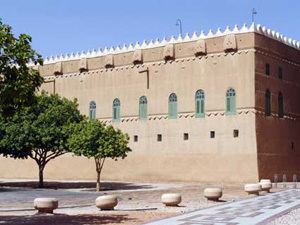Client King Abdulaziz Opened 1938 Architectural style Islamic architecture | Completed 1938 Size 7,000 square-metre Construction started 1936 | |
 | ||
Similar Masmak fort, Al Faisaliyah Center, Kingdom Centre, Idrisid houses, Ibrahim Palace (castle) | ||
Chinese president visits murabba palace in riyadh
The Murabba Palace (Qasr al Murabba (the Square in Arabic)) is one of the historic buildings in Riyadh, Saudi Arabia. The palace was named after its square with the form of 400 by 400 metres (1,300 by 1,300 ft). It is one of the museums in the city.
Contents
- Chinese president visits murabba palace in riyadh
- Map of Murabba Palace Al Murabba Riyadh 12631 Saudi Arabia
- Saudi dancers perform folklore to welcome chinese president at murabba palace
- History and location
- Layout and style
- Current usage
- References
Map of Murabba Palace, Al Murabba, Riyadh 12631, Saudi Arabia
Saudi dancers perform folklore to welcome chinese president at murabba palace
History and location
The palace was built by King Abdulaziz outside Riyadh, being the first major expansion of the city in the twentieth century. Construction was started in 1936, partly finalized in 1938 and fully completed in 1945. The palace was intended to be a family residence and court for the king. With the construction of the palace three novel technologies were introduced to the Saudi society: the use of the automobiles as means of transportation, electricity by means of generators and water closets with drainage systems.
The king left his former court in Masmak fort when the construction was finished, and used the palace as his residence and court from 1938 until his death in 1953. However, another palace, Addeera, was also used as royal residence.
During this period Murabba Palace witnessed many official visits and sign of various agreements. A lift was installed into the Murabba Palace in the late 1940s when the king had difficulty in climbing the stairs due to advanced arthritis. It was the first lift in Saudi Arabia. The king appointed one of his sons, Prince Mansour, as emir of the palace.
The Murabba palace is situated two kilometers north of the old city of Riyadh and its total area was over 16 hectar. It is located about half a mile from Masmak fort. The area where the palace was constructed was called Murabba Al Sufyan. In the south of the palace there are gardens and the Batha valley is situated in the east. Wadi Abu Rafie is in the west and small hills lie on the north of the palace.
Layout and style
The palace is a complex of palaces used for different purposes, housing two stories with 32 rooms. Overall shape of the building is cubic. It is made up of residential buildings, service facilities and the diwan of the king. These buildings are surrounded by a courtyard. A huge brick wall also surrounds the palace and there are nine gates. The main gate was originally on the west side, but, later the gate on the southern side was used as main entrance which allowed a short link to the nearby mosque.
The upper floor of the building used for court of the king included audience hall, offices of administrative affairs, communications and guest chambers. The ground floor housed the offices for palace utilities, security and administration.
It has a plain style and reflects the general features of the traditional Najdi architecture. The building also reflects the general characteristics of Najd's urban pattern, namely solid masses, covered streets, and the integration of courtyards. The palace was built mainly by bricks, indigenous stones, tamarisk trunk and palm-leaf stalks. The walls of the building were made by straw reinforced adobe, and have engraved ornaments on coating. Local Acacia with palm frond matts was used for the ceiling of the palace. The wood beams supporting the ceiling have decorations with yellow, red, and black geometric patterns.
Current usage
A development project was initiated by the Supreme Commission of Tourism and Antiquities in 1999 to renovate the Murabba palace. It was converted into a museum that is open to public visits. It was called "living museum" after renovation. It is part of the King Abdulaziz Darat or King Abdulaziz Historical Center.
In the current usage, the ground floor includes the guards' room and stores for food, coffee, wood and other materials needed for cooking. The upper floor is made up of salons and waiting rooms for visitors. There several historic garments and crafts are exhibited. There is also the King Abdulaziz memorial hall and a written and photographic archive centre in the building.
